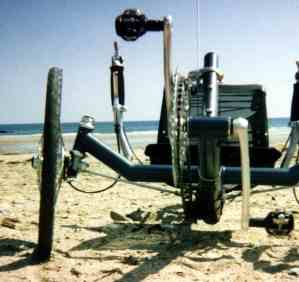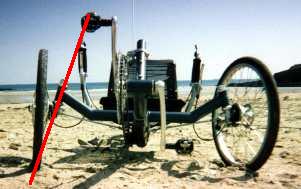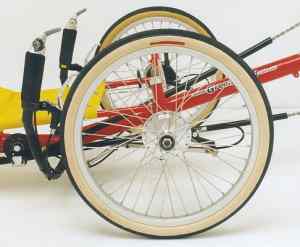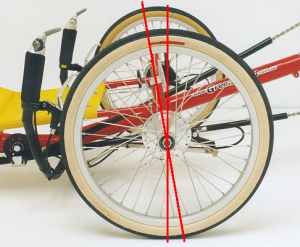Tricycle steering geometry - introductionCorrect steering geometry is particularly important for human-powered vehicles, because if tyres scrub as you turn, the energy wasted can significantly slow you down. It can also end up being expensive in tyres! The design method often used to minimise this effect is also useful for lightweight electric or solar vehicles - in fact, pretty much any multitrack vehicle. There are several aspects to steering design:
In more detail: Ackermann steering geometryWhen a trike or quad goes round a corner, it turns around a point along the line of its rear axle. As the diagram shows, this means that the two front wheels will have to turn through slightly different angles so that they are also guiding the vehicle round this point, and not 'fighting' the turn by scrubbing. As the diagram below shows, the inside wheel turns through a greater angle than the outer. 
Ackermann geometry is simply steering which achieves this, keeping each front wheel at the correct angle, through the whole range of the steering motion. Even with perfect Ackermann steering, there will still be some scrub, because of dynamic effects (the trike tries to go straight on, the tyres push it round the corner, so it tends to understeer). Some builders 'tweak' the Ackermann model to take account of this, usually by arranging that the wheels remain more close to parallel than exact Ackermann would suggest. Having said that, pure Ackermann works pretty well - and it doesn't have to be perfect. Centrepoint steeringLook at most recumbent trikes from the front and you'll notice that the kingpins slope outwards, like this: 
 Images courtesy of ICE via
the Trikes CD-ROM.
Images courtesy of ICE via
the Trikes CD-ROM.
The idea is that the kingpin axis meets the ground at or near the contact point of the tyre - the so-called 'centre point'. The rather crudely-drawn red line on the diagram shows this. Then if the wheel hits a bump, the forces from this impact will be in line with the turning axis, so no torque can be exerted which might jerk the steering. Also, if just one of the front wheels is braked, or the two front wheels are braked unevenly, the forces should again all pass through the kingpin axes and not affect the steering. The kingpin inclination which is used to achieve this should be kept to a minimum to keep the steering from becoming heavy: the greater the angle, the more steering motion needs to lift the weight of the trike as you turn. Most builders keep the kingpin inclination to around say 15 degrees, preferably less. Many designs have the kingpin axis hit the ground a little in from the exact centre of the tyre contact point: this gives a certain amount of 'road feel'. Others put the intersection of kingpin axis and ground outside the tyre contact point in an effort to reduce or eliminate brake steer. Commercial manufacturers have done a lot of work refining their steering: some have virtually eliminated brake steer, and use separate braking systems for each front wheel, each one controlled by one of the rider's hands. Lack of brake steer makes this a practical arrangement, as the handling is relatively unaffected when braking with just one hand, such as when indicating. Others link the front brakes using hydraulics, careful adjustment or mechanical linkages to balance the braking between the two front wheels, and controlling both front brakes from a single lever. Centrepoint steering is less critically important in this arrangement. Caster, trailJust like a two-wheeler, a trike's steering needs to self-centre if it's to handle well, and especially to be stable at speed. And just as on a two-wheeler, this is usually achieved by inclining the steering axis (the steerer tube on a bike). 
 Images courtesy of Greenspeed via
the Trikes CD-ROM.
Images courtesy of Greenspeed via
the Trikes CD-ROM.
Clearly, this inclination is in a plane at right angles to the centrepoint steering inclination we've just mentioned: that is an angle seen as viewed from the front of the trike: the caster angle is as viewed from the side. Around 10-14 degrees of kingpin caster inclination seems to work OK on most designs. Caster effect can also be achieved with no kingpin inclination, offsetting the axle mounting points from the kingpin axis instead. Read up about 'trail' at, for example, Sheldon Brown's splendid website if you're interested. But most commercial trikes seem to just mount the axle right on the kingpin axis. Other considerations
|